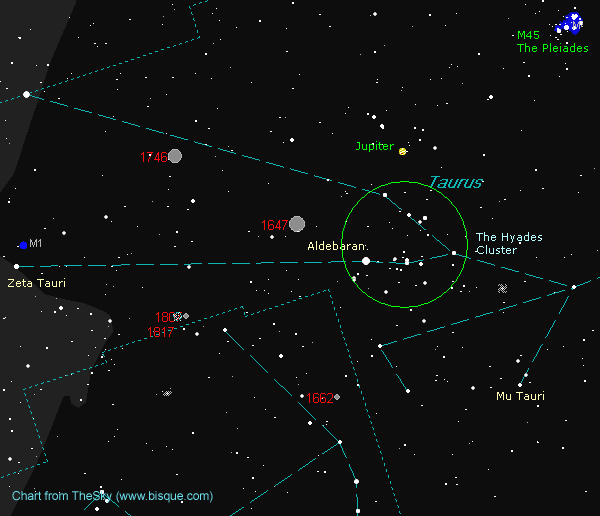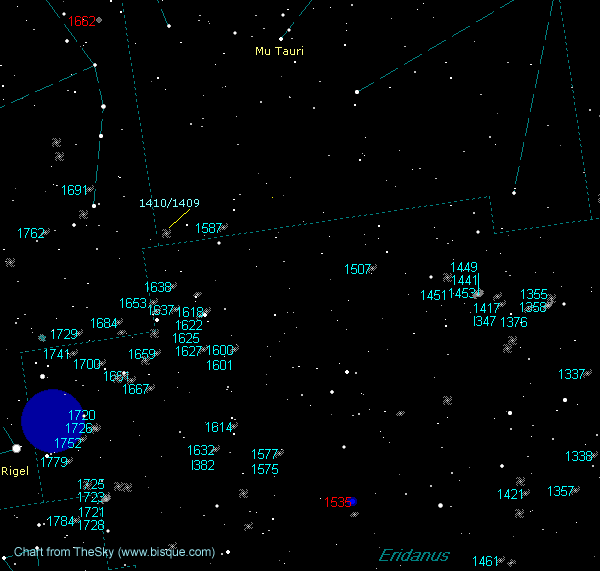A Winter Comet
Happy New Year everyone. As I wrote a few months ago, 2013 will be the year of brilliant comets including C/2012 S1. If the predictions hold, the comet will be a binocular object in August and moving up to naked eye status by November when it peaks at month’s end. Astronomers estimate C/2012 S1 will outshine the full moon thus becoming the brightest comet in history and be seen during the day. Only time will tell and is still many months away.
But for now, we have Comet C/2012 K5 (Linear) that was gliding through Ursa Major and is now moving quickly in Auriga. At magnitude 6.5, it should be an easy catch in any telescope. Let us not forget Comet 168P/Hergenrother that is well-placed overhead and only a few arc minutes from the Andromeda Galaxy. At magnitude 11.3, this one might be a bit more difficult.
Anyone walking the dog or taking a stroll around supper time on a clear night will notice the wealth of bright stars in the eastern sky. By 8 p.m. the bright suns of Taurus, Auriga, Orion, Gemini, Canis Minor and Canis Major are all visible. The crisp wintery air magically allows them to shine even greater. Along with these mini beacons is the king of planets – Jupiter. In fact, this planet is well placed between the Pleiades Cluster (M45) on its right and Aldebaran with the ‘V’ shaped Hyades cluster to its left. Here is a little example of perspective.
Although the sky appears as white dots on a black wall and all seem to be the same distance from us, they reside at different distances like cars in a shopping mall parking lot. For instance, Jupiter is a mere 49 light minutes from us while super-giant Aldebaran is just over 65 light-years away. Meanwhile, the Hyades Cluster is listed at 153 light-years away and the Pleiades Cluster is close to 430 light-years. So next time you are scanning or imaging these four objects, picture them in a distance scale. More on Jupiter later.

From Aldebaran, move some 15 degrees to the left till you come to the end of the bull’s left horn. At a distance of 420 light-years, third magnitude Zeta Tauri is a class B2 blue subgiant star with a surface temperature of 22,000 Kelvin. It spins at an astonishing 330 kilometres per second or 115 times fast than our Sun. From here, move a little more than a degree north till you come across a faint patch of light. You are now looking at the smoky remains of a once-living star, welcome to the Crab Nebula. This was the first entry on Charles Messier’s list of known cometary objects and is so catalogued as M1.
Imagine you are back in the year 1054. An especially bright star some four times brighter than Venus appears and for 23 days was seen during daylight hours. The Crab is located some 6,500 light-years away – a nice safe distance because the estimated energy of 400 million suns was released in the blast. As in most cases – a neutron star remains as the only After this mammoth explosion the remaining neutron star now measures 30 km across and spins at 30 times per second (movie).
Using Aldebaran as a marker, move three and a half degrees to a bright scattered open star cluster registered as NGC 1647. It measures 45 arc minutes wide and is listed at magnitude 6.4 or just under naked eye visibility. This would be a great visual test from a dark sight when the moon is absent. Because of its size, this splash of ten stars is best seen in wide-angle binoculars.
If you like to hunt down remote galaxies, numerous targets are set on the Taurus/Eridanus border with more below Orion’s shield. Epsilon Tauri is a bright 3.6 orange giant star 147 light-years away with a spectral class K0. For a real challenge, locate the pair of interacting galaxies (NGC 1410/1409) on the southern border of Taurus. These two reside some 300 million light-years away and are around the fifteenth magnitude range. In 2007 astronomers discovered one extrasolar planet orbiting this sun. Now move your scope one and third degrees west to NGC 1555 – aka Hind’s variable nebula. Here we are witnessing the early stages of a new star’s development still embedded in its molecular cloud.

Other than the moon when present, Jupiter rules the night till it sets at about 5 a.m. local time. The King of Planets is presently in retrograde motion and moving westward with the stars. This is the result of Earth moving faster as does a race car on the inside lap. Jupiter will become stationary on the 30th and then continue its usual easterly motion against the stars. Check the 2013 edition of the Royal Astronomical Society of Canada’s Observer’s Handbook for numerous satellite and shadow timings.
The gibbous moon brushes by Jupiter on the night of the 21st. Saturn is slowly distancing itself from the morning solar glare and is visible in the ESE around 3:30 a.m. local time at the beginning of the month and two hours early at month’s end.
The first meteor shower of the New Year will peak on the night of January 2 at 10 p.m. EST. Anywhere from 80 to 100 shooting stars can be seen in an hour during this peak but you will have a few hours of dark sky as the moon will rise at 12:39 a.m. local time. Speaking of the moon, this month’s new moon occurs on the 11th at 2:14 p.m. EST while the full Wolf Moon occurs on the Jan 26, 11:38 p.m.
Until next month, clear skies everyone.
